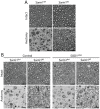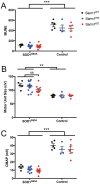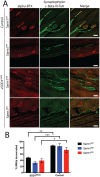Loss of Sarm1 does not suppress motor neuron degeneration in the SOD1G93A mouse model of amyotrophic lateral sclerosis
- PMID: 30010873
- PMCID: PMC6196650
- DOI: 10.1093/hmg/ddy260
Loss of Sarm1 does not suppress motor neuron degeneration in the SOD1G93A mouse model of amyotrophic lateral sclerosis
Abstract
Axon degeneration occurs in all neurodegenerative diseases, but the molecular pathways regulating axon destruction during neurodegeneration are poorly understood. Sterile Alpha and TIR Motif Containing 1 (Sarm1) is an essential component of the prodegenerative pathway driving axon degeneration after axotomy and represents an appealing target for therapeutic intervention in neurological conditions involving axon loss. Amyotrophic lateral sclerosis (ALS) is characterized by rapid, progressive motor neuron degeneration and muscle atrophy, causing paralysis and death. Patient tissue and animal models of ALS show destruction of upper and lower motor neuron cell bodies and loss of their associated axons. Here, we investigate whether loss of Sarm1 can mitigate motor neuron degeneration in the SOD1G93A mouse model of ALS. We found no change in survival, behavioral, electrophysiogical or histopathological outcomes in SOD1G93A mice null for Sarm1. Blocking Sarm1-mediated axon destruction alone is therefore not sufficient to suppress SOD1G93A-induced neurodegeneration. Our data suggest the molecular pathways driving axon loss in ALS may be Sarm1-independent or involve genetic pathways that act in a redundant fashion with Sarm1.
Figures





Similar articles
-
Sarm1 deletion suppresses TDP-43-linked motor neuron degeneration and cortical spine loss.Acta Neuropathol Commun. 2019 Oct 28;7(1):166. doi: 10.1186/s40478-019-0800-9. Acta Neuropathol Commun. 2019. PMID: 31661035 Free PMC article.
-
Genetic diversity of axon degenerative mechanisms in models of Parkinson's disease.Neurobiol Dis. 2021 Jul;155:105368. doi: 10.1016/j.nbd.2021.105368. Epub 2021 Apr 20. Neurobiol Dis. 2021. PMID: 33892050 Free PMC article.
-
Sarm1 knockout modifies biomarkers of neurodegeneration and spinal cord circuitry but not disease progression in the mSOD1G93A mouse model of ALS.Neurobiol Dis. 2022 Oct 1;172:105821. doi: 10.1016/j.nbd.2022.105821. Epub 2022 Jul 18. Neurobiol Dis. 2022. PMID: 35863521
-
Axon Biology in ALS: Mechanisms of Axon Degeneration and Prospects for Therapy.Neurotherapeutics. 2022 Jul;19(4):1133-1144. doi: 10.1007/s13311-022-01297-6. Epub 2022 Oct 7. Neurotherapeutics. 2022. PMID: 36207571 Free PMC article. Review.
-
Axons Matter: The Promise of Treating Neurodegenerative Disorders by Targeting SARM1-Mediated Axonal Degeneration.Trends Pharmacol Sci. 2020 Apr;41(4):281-293. doi: 10.1016/j.tips.2020.01.006. Epub 2020 Feb 24. Trends Pharmacol Sci. 2020. PMID: 32107050 Review.
Cited by
-
Sarm1 deletion suppresses TDP-43-linked motor neuron degeneration and cortical spine loss.Acta Neuropathol Commun. 2019 Oct 28;7(1):166. doi: 10.1186/s40478-019-0800-9. Acta Neuropathol Commun. 2019. PMID: 31661035 Free PMC article.
-
Glial TGFβ activity promotes neuron survival in peripheral nerves.J Cell Biol. 2023 Jan 2;222(1):e202111053. doi: 10.1083/jcb.202111053. Epub 2022 Nov 18. J Cell Biol. 2023. PMID: 36399182 Free PMC article.
-
Genetic diversity of axon degenerative mechanisms in models of Parkinson's disease.Neurobiol Dis. 2021 Jul;155:105368. doi: 10.1016/j.nbd.2021.105368. Epub 2021 Apr 20. Neurobiol Dis. 2021. PMID: 33892050 Free PMC article.
-
Ubiquitin Proteasome System and Microtubules Are Master Regulators of Central and Peripheral Nervous System Axon Degeneration.Cells. 2022 Apr 15;11(8):1358. doi: 10.3390/cells11081358. Cells. 2022. PMID: 35456037 Free PMC article. Review.
-
SARM1 knockout does not rescue neuromuscular phenotypes in a Charcot-Marie-Tooth disease Type 1A mouse model.J Peripher Nerv Syst. 2022 Mar;27(1):58-66. doi: 10.1111/jns.12483. Epub 2022 Feb 13. J Peripher Nerv Syst. 2022. PMID: 35137510 Free PMC article.
References
-
- Lunn E.R., Perry V.H., Brown M.C., Rosen H. and Gordon S. (1989) Absence of Wallerian degeneration does not hinder regeneration in peripheral nerve. Eur. J. Neurosci., 1, 27–33. - PubMed
-
- Mack T.G., Reiner M., Beirowski B., Mi W., Emanuelli M., Wagner D., Thomson D., Gillingwater T., Court F., Conforti L. et al. (2001) Wallerian degeneration of injured axons and synapses is delayed by a Ube4b/Nmnat chimeric gene. Nat. Neurosci., 4, 1199–1206. - PubMed
Publication types
MeSH terms
Substances
Grants and funding
LinkOut - more resources
Full Text Sources
Other Literature Sources
Medical
Molecular Biology Databases
Miscellaneous

